All types of black caterpillars are menacing appearances to scare away potential predators and camouflage their habitats. These black caterpillars are native to North America and defoliate trees, shrubs, herbs, flowers, and grasses.
Identifying these caterpillars can be a daunting experience for beginners since they keep changing their colors throughout their growth stages. Here is a guide that provides insight into black caterpillar identification
Are Black Caterpillars Poisonous?
Most black caterpillars in North America are harmless and non-poisonous. But those with bright color patterns seen all over the black bodies might make them appear dangerous and poisonous.
Research shows that bright-colored caterpillars sting and inject venom into their potential predator. The toxic substance may cause skin irritation and nasty rashes on human skin after the black spikes in it.
We recommend not handling or touching black caterpillars despite them being harmless and non-venomous. Use chemicals to eliminate these caterpillars in your garden. (Source: Oklahoma University).
Different Types of Black Caterpillars
Here is a list of 20 types of black caterpillars native to North America and some parts of Europe. Use the description and pictures to help in caterpillar identification:
Woolly Bear Caterpillar
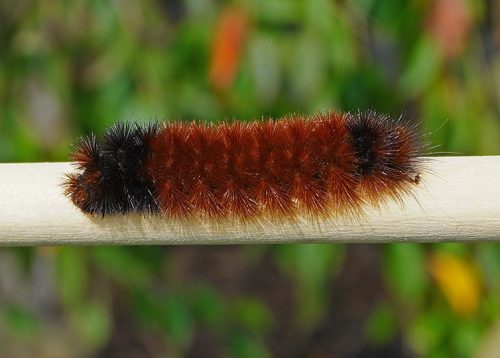
It is a black hairy caterpillar that loves crawling in the garden or park. These fuzzy black and brown caterpillars are often seen in the late summer.
The furry caterpillar has a prominent orange or brown band around the middle section with black ends. These grubs have spiky tufts that can cause skin irritation and rashes.
Woolly bear caterpillars roll up into spiky balls when threatened. You will notice them crawling away for safety once the threat disappears.
Woolly bear caterpillars are also called Isabella Tiger Moth caterpillars. These crawling creatures feed on herbs, tree leaves, and other plants.
Scientific Name |
Pyrrharctia isabella |
Host Plants |
Asters, Birches, Clovers, Corns, Elms, maples, and sunflowers |
Identification Features |
Tufts of brown or orange hairs at the middle and black spiky ends. |
Giant Leopard Moth Caterpillar
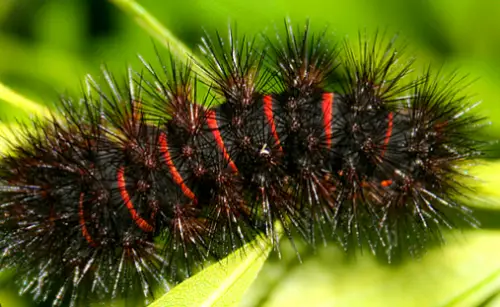
These are moth caterpillars that love munching the leaves of plants in the garden. They have a fluffy appearance and needle-like spikes on their back.
Giant leopard moth caterpillars do not sting though the sharp spikes can prick your skin when handling them without protective gear.
These black caterpillars are native to Florida, Texas, Mexico, and some parts of the East Coast in the United States. They have red bands between the black spikes for defense.
Scientific Name |
Hypercompe scribonia |
Host Plants |
Banana, cherry, cabbage, maples, orange, and willows. |
Identification Features |
Black fuzzy caterpillar with black spikes and red stripes between them. |
Garden Tiger Moth Caterpillar
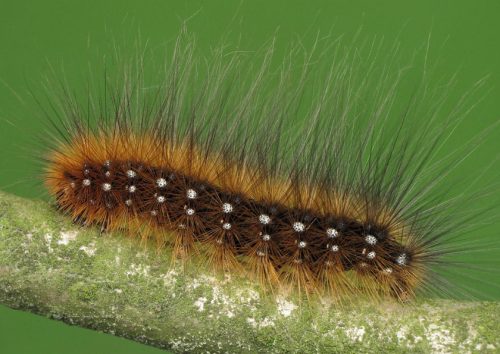
It is a beautiful crawling insect with grayish, white, or orange lines on its body. The garden tiger moth caterpillar is also called Artica Caja.
The moth larva has long setae that are black, orange, and grayish-white. Refrain from handling these caterpillars since the hair tufts can cause skin irritation and nasty rashes.
Garden tiger moth caterpillars feed on any plant leaves and can grow up to 6cm long. It turns into a striking moth with a pair of black and white wings.
Scientific Name |
Arctia caja |
Host Plants |
Broad-leaved dock, common nettle, and burdocks |
Identification Features |
Fuzzy-looking black caterpillar with orange spines and long spiky gray hairs. |
Scarce Dagger Moth Caterpillar
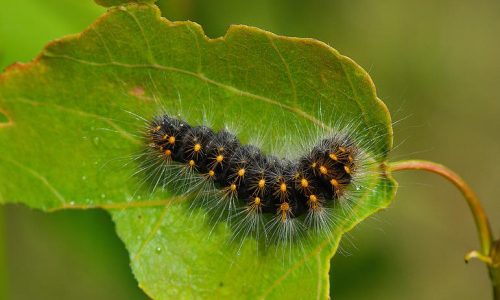
The crawling insect has a pure black body with tufts of black and orange or yellow setae or spines. This black and orange caterpillar is moderately fuzzy compared to others.
Each segment has a pair of small clumps of fine hairs with spines of the head and tail for easy identification. The bright yellow or orange tufts of hair are in the middle section.
These furry black caterpillars can cause skin irritation although they are non-poisonous or non-toxic. They turn into dagger moths with several markings after pupation.
Scientific Name |
Acronicta auricoma |
Host Plants |
Oak, Rubus, Calluna, and Vaccinium |
Identification Features |
Unique yellow or white dots and tufts of yellow or orange spines on the black fuzzy body. |
Walnut Caterpillar
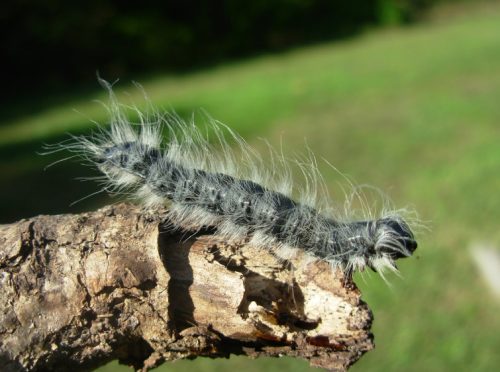
It is a black crawling creature with long white spindly spines around its body. These caterpillars move around in groups or travel in long lines on their host plants.
Walnut caterpillars are also called processionary caterpillars due to their movement behaviors. These hairy black caterpillars are harmless and don’t skin irritation.
Scientific Name |
Datana integerrima |
Host Plants |
Black and English walnut, butternut, and pecan. |
Identification Features |
Shiny plump black body with fuzzy wispy appearance. |
Black Swallowtail Caterpillar
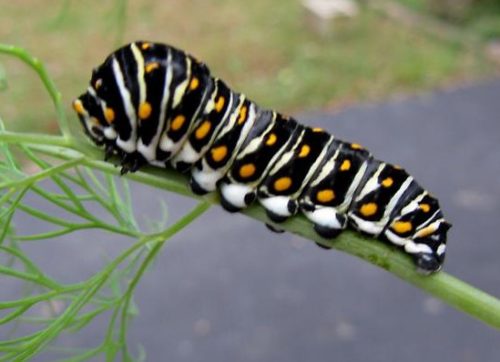
It is a short plump butterfly caterpillar with yellow and white markings. These butterfly larvae keep changing colors throughout their growth stages.
A mature black swallowtail caterpillar has a bright green body with black and yellow stripes. The black and white saddle markings are signs of pupation stage loading.
These crawling insects resemble bird poop for defense mechanisms. They feed on the leaves of carrots, parsley, and other green leaves.
These grubs are also called parsnip swallowtails or parsley worms due to the type of plants they eat. They also have tiny soft spines on the segments.
Scientific Name |
Papilio polyxenes |
Host Plants |
Carrots and parsley |
Identification Features |
Black segmented body with rows of yellow and white dots. |
Peacock Butterfly Caterpillar
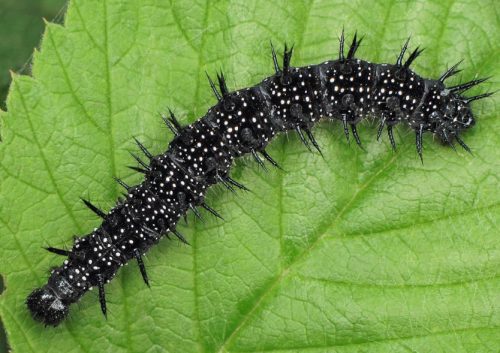
It is a strange-looking black caterpillar with a round black head and multiple segments for easy recognition. The shiny spikes on the segments are distinctive features.
The peacock butterfly caterpillar is harmless despite having sharp spikes on its body. I recommend not handling or touching them with bare hands.
Other distinctive features are the tiny white dots covering its body and shiny black segments to give a speckled appearance.
Scientific Name |
Aglais io |
Host Plants |
Stinging nettle, hop, and small nettle. |
Identification Features |
Cylindrical slender body with soft black bristles and white dots. |
Mourning Cloak Caterpillar
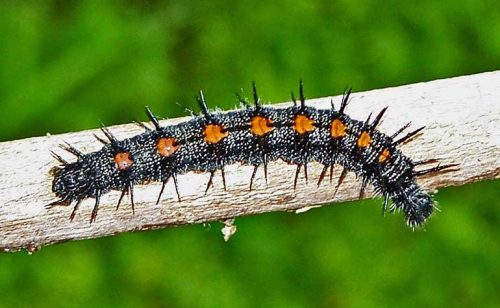
It is a black spiky caterpillar that loves feeding on the foliage of elm trees. The mourning cloak caterpillars are also called spiny elm caterpillars due to the plant they eat.
They have long dark gray bodies with reddish-orange markings on each segment. The tiny white flecks covering the body are ideal for easy identification.
The dark black line running up the back is another distinctive feature. The sharp spiny spines are non-toxic but for self-defense.
Scientific Name |
Nymphalis antiopa |
Host Plants |
Hackberry, cottonwood, poplar, rose, birch, hawthorn, and mulberry. |
Identification Features |
Spiky black body with rows of reddish-brown dots running up its back. |
Pipevine Swallowtail Caterpillar
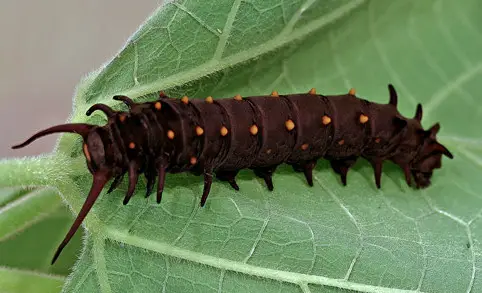
It is another black spiky caterpillar native to Florida, Texas, and California. These caterpillars have smooth bodies featuring bright red or orange spines.
These crawling insects are harmless despite having a jaggy appearance. The spines act as a self-defense mechanism against predators.
These larvae feed on pipevine plants that contain toxic substances. They can kill birds and other insects if consumed in large quantities.
The reddish-orange and black spikes make these caterpillars appear harmful. But they do not sting humans and pets.
Scientific Name |
Battus philenor |
Host Plants |
Thistle flowers, ironweed, and phlox flowers. |
Identification Features |
Jet black body with red-orange spikes on all sides of the body. |
Black Cutworm Caterpillar
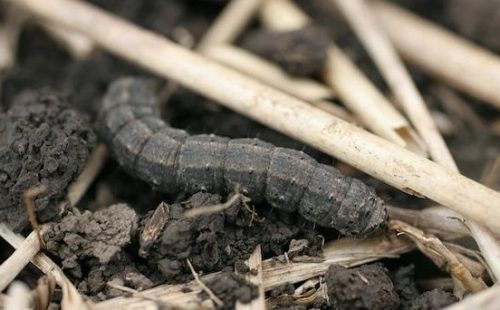
It is a fat long dark brown-gray larva that looks almost black. The dark body caterpillar lack hairs, spines, or spikes.
These caterpillars derive their name from the ability to cut down plants at the stem in the garden or yard. These grubs destroy the plant from the roots and feed on leaves.
These plump crawling creatures come in a range of colors from gray to brown to almost black. The head is covered in black freckles for easy identification and recognition.
Scientific Name |
Agrotis ipsilon |
Host Plants |
Seedlings of crops |
Identification Features |
Smooth shiny body |
Catalpa Sphinx Caterpillar
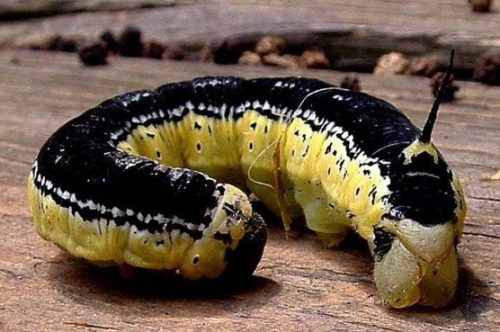
It is a striking black caterpillar also called a catalpa worm. These crawling insects feed on the foliage of deciduous trees and shrubs.
These hawk moth caterpillars have shiny jet-black bodies at maturity, while the juvenile counterparts have light colors with few markings.
When these crawling insects become pure black, it is a sign of pupation. The yellow markings on the sides are other distinctive features for easy identification.
The menacing appearance does not make these caterpillars harmful. But refrain from handling or touching them to avoid any skin problems.
Scientific Name |
Ceratomia catalpae |
Host Plants |
All deciduous trees and shrubs |
Identification Features |
Shiny black segments with yellow sides |
Azalea Caterpillar

It is a black caterpillar that hails from Florida, Kansas, and the East Coast States. The markings are more or less black depending on the growth stage.
Other distinctive features are the globular orange head, an orange rear part, and several yellow markings around its body. The crawling insect also has strange reddish-brown legs.
The noticeable spindly hairs are insignificant and do not make the caterpillar appear fuzzy or hairy. They feed in colonies and can be a nuisance to farmers or gardeners.
Scientific Name |
Datana major |
Host Plants |
Blueberry, oak, and apple. |
Identification Features |
Long black and yellow bands with a silky-smooth body. |
Tersa Sphinx Caterpillar
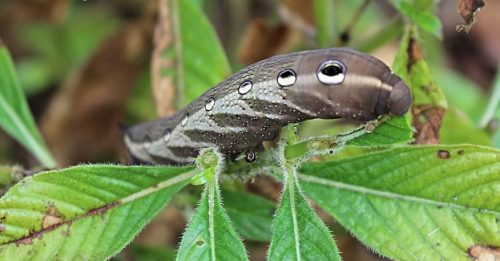
It is a strange-looking dark or almost black caterpillar that hails from the Southern States of the U.S.A. These caterpillars are common in Texas, Arizona, and Central and South America.
The dark-colored caterpillar has distinctive eye markings along its body and a horn on its end. Juvenile counterparts have light brown beige with dark brown eye markings. They are harmless and do not sting or bite.
Scientific Name |
Xylophanes tersa |
Host Plants |
Smooth button plants, Pentas, Catalpa, and Manettia. |
Identification Features |
Defensive markings that look-like eyes |
White-lined Sphinx Caterpillar
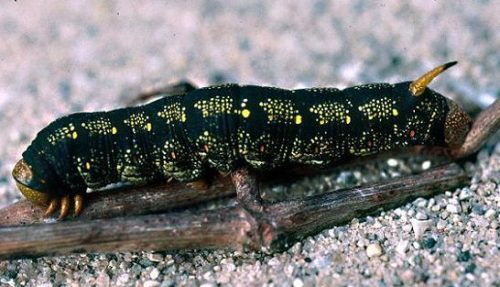
It is a hawk moth caterpillar that comes in different colors. Some species have black and orange colors and others have bright green bodies.
White-lined sphinx caterpillars are the black species with a single orange horn on their tail end. The horn can be yellowish with a black tip depending on the growth stages.
The white or orange markings are distinctive features of sphinx caterpillars. The small dots clusters and large dots on its sides are other features for identification.
Scientific Name |
Hyles lineata |
Host Plants |
Cardinal flowers, evening primrose, honeysuckle, and jimson weed. |
Identification Features |
Plump black body with orange markings and a unicorn-like spine on the back of the body. |
Great Spangled Fritillary Caterpillar

It is a black caterpillar with yellow or orange spines and loves feeding on the leaves of violet plants. These caterpillars live close to the ground to hide from predators.
These crawling creatures turn into striking butterflies after pupation. The orange and black butterflies are often seen the mid-summer.
Scientific Name |
Speyeria cybele |
Host Plants |
Violets |
Identification Features |
Black body with yellow or orange spines |
The Red Admiral Caterpillar
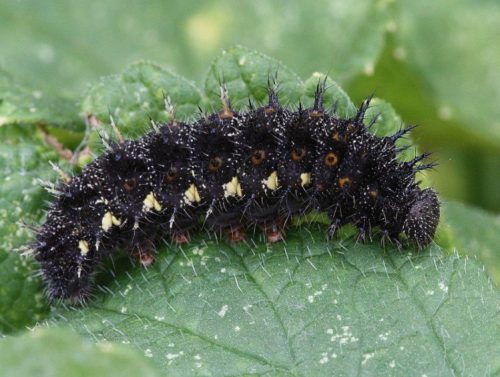
It is a black butterfly caterpillar native to the Eastern part of the United States. The spiny black caterpillar has yellow stripes down each side.
These crawling insects feed on nettles and make webs to protect dozens of individual caterpillars from predators. They form nests along the roadsides or stream banks.
The red admiral caterpillars turn into beautiful caterpillars with bright red bands and blue spots after pupation. The male species patrol its territory in the afternoon.
Scientific Name |
Vanessa atalanta |
Host Plants |
Nettle plants and milkweeds |
Identification Features |
Spiny black caterpillar with yellow stripes of markings. |
Spongy Moth Caterpillar
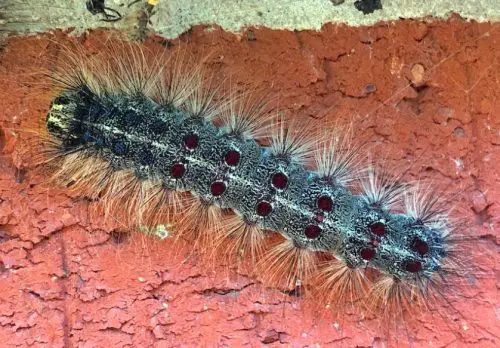
It is a black caterpillar with orange stripes on its back. These crawling creatures go through six growth stages with each having unique features.
The late growth stages of spongy moth caterpillars are quite destructive. These crawling insects munch on the leaves of trees and low-growing crops.
These caterpillars climb the trees at night and come back to lower-level leaves during the day. Use chemical treatments to eliminate these pests from your crops or trees.
Scientific Name |
Lymantria dispar |
Host Plants |
Oaks, birches, crabapple, willow, aspen, and linden plants. |
Identification Features |
Black body with orange stripes on its back |
Common Buckeye Caterpillar
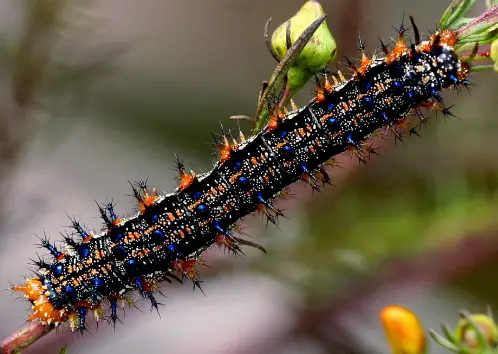
It is a black coloring caterpillar with white patterns and orange marks. The caterpillar feeds on a vast number of flowers including false foxgloves or monkey flowers.
The crawling insect turns into a beautiful butterfly with brown and black colors after pupation. The orange colorings on butterflies are more conspicuous than on caterpillars.
Scientific Name |
Junonia coenia |
Host Plants |
Snapdragon, gerardia, false foxglove, monkey flowers, and plantains |
Identification Features |
Black coloring with white patterns and orange marks. |
Painted Lady Caterpillar
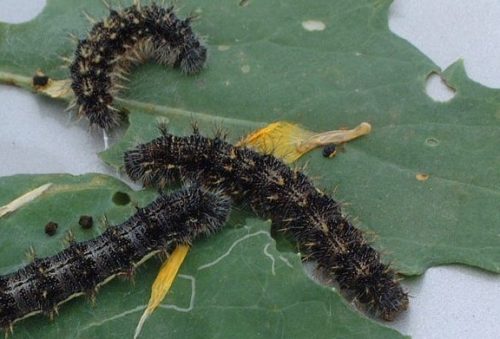
Juvenile caterpillars are light green and slowly turn into black individuals. The mature American lady caterpillars are pure black after passing through gray growth phases.
The bright bands and black bristles are the distinctive features for identification. Refrain from handling or touching these caterpillars to avoid skin irritation.
Scientific Name |
Vanessa cardui |
Host Plants |
Blazing star, cosmos, New England aster, Joe-pye weed, Mexican sunflower, purple coneflower, and zinnias |
Identification Features |
American Lady Caterpillar
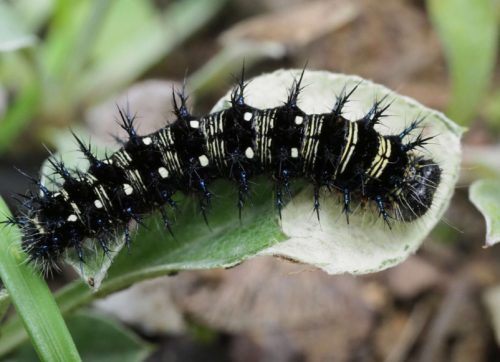
It is a black caterpillar with bright bands around its body. The small white dots and contrasting colors are the distinctive features.
These crawling insects thrive in the warm climate of Florida State and are seen once in a year. They create silk-made protective structures on top of flowers and leaves to hide from predators.
Scientific Name |
Vanessa virginiensis |
Host Plants |
Spoonleaf purple everlasting, Gamochaeta purpurea (L.) Cabrera |
Identification Features |
Black caterpillar with bright bands and small white dots |
People Who Read This Also Read:






